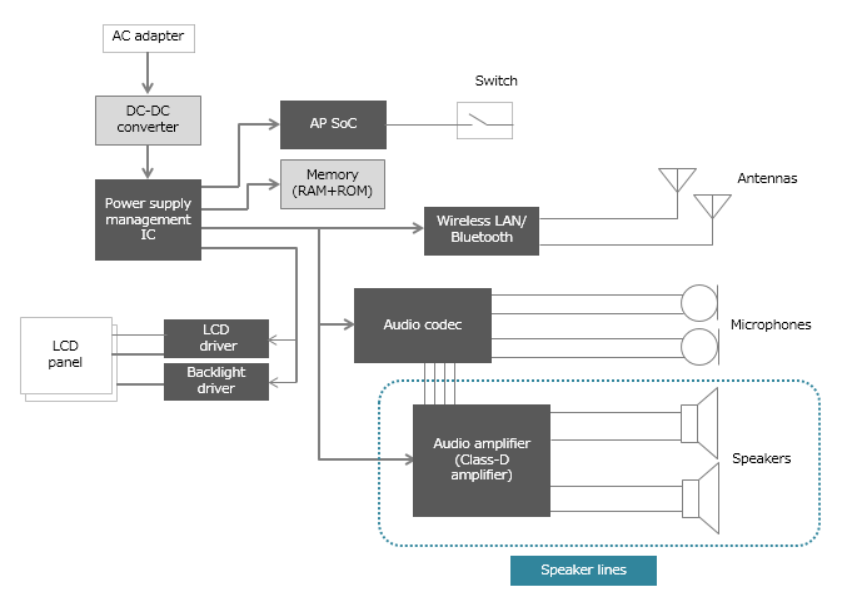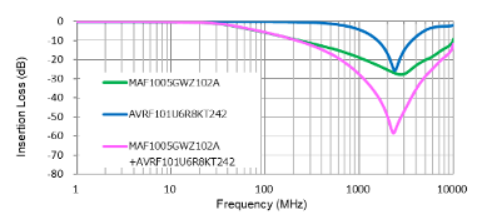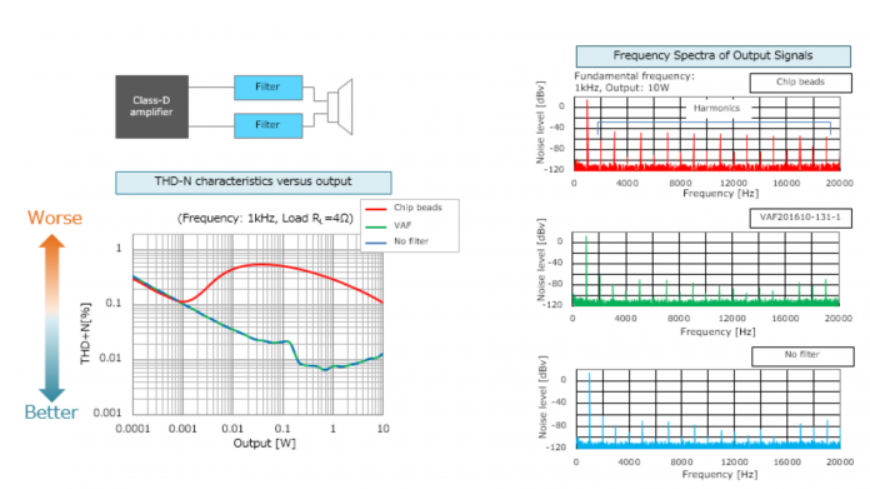Due to their small size and high energy efficiency, Class D amplifiers have become a fixture in smartphones and battery-powered artificial intelligence (AI) speakers, where space and power budgets are very tight. They have replaced Class A and Class AB amplifiers, both of which offer excellent linearity, high gain, and low signal distortion levels, but are very power hungry.
Class D amplifiers are one of the key technology elements that have enabled the exponential growth in consumer demand. These nonlinear switching amplifiers can theoretically achieve 100% efficiency. Unlike Class A and Class AB, current flows only through transistors that are turned on. However, the significant advantage of Class D amplifiers also has a disadvantage, which is the potential for noise generated by their high-speed switching (Figure 1).

Figure 1 High-speed switching can generate noise in audio devices such as smart speakers. Source: TDK
Therefore, design engineers must take effective noise countermeasures. However, at the same time, these measures should neither increase the board area nor affect the signal and audio quality, which means that the performance of the noise suppression filter inserted in the speaker line is very important. The sound quality of the speaker is also affected by the performance of the inductor used in the low-pass filter (LPF) of the Class D amplifier output stage.
In addition, anti-static measures (ESD) are often necessary in speaker lines. Here, ESD notch filters with multilayer varistor technology protect both ESD-related transient overvoltages and filter noise sources associated with wireless communications.
ESD notch filters also play a key role in suppressing radiated noise. Multilayer varistors have specific parasitic capacitances designed to work in concert with filtered noise sources associated with interference in the cellular, Bluetooth, or Wi-Fi bands (Figure 2).

Figure 2 The MAF and AVRF series filters work together to reduce insertion loss. Source: TDK
The basic application methods to achieve these functions are summarized below.
100 mW to 2 W Audio
In the speaker lines of smartphones and other devices with relatively small speaker output (100 mW to 2W), Class D amplifiers without LPF are often used. Sound distortion is usually expressed in digital form as total harmonic distortion plus noise (THD+N); the lower its value, the better the sound quality.
If general-purpose chip beads are used in speaker lines, the output causes an increase in the THD+N value, which degrades the sound quality. However, with a noise suppression filter, the THD+N characteristics are equivalent to those when no filter is used. Even if the output power is increased, there is no effect on the signal and no sound distortion occurs. Using the frequency spectrum of the output signal (1 kHz), the harmonic level is significantly higher when using chip beads; this harmonic component is called distortion. In contrast, when using a noise suppression filter, high frequencies are not affected, so only a clean 1 kHz signal can be heard.
Noise suppression filters are as effective in suppressing radiated noise as turning off a Class D amplifier, compared to not using a filter. For example, TDK's MAF series filters are multilayer chip components that use a new type of ferrite material to achieve low distortion while maintaining its noise-canceling properties.
2 W to 20 W Class Speaker Cables
For devices with speaker outputs in the 2 W to 20 W range, such as AI speakers, tablets, and other audio devices, it is necessary to provide inductance to the LPF externally to accommodate large currents. Considering that these inductors are inserted into the speaker lines, they must not affect the signals in these lines.
Metal inductors are made of metal magnetic materials. They can accommodate high currents; however, the THD+N value increases with output power. Inductors with a wire-wound shielded magnetic structure using ferrite can provide many advantages, including low DC resistance, Rdc, and the ability to accommodate high currents. Therefore, when plugged into a speaker, the THD+N value changes only slightly.
As with lower output power smartphone speakers, adding noise suppression filters to the speaker lines in the 2 W to 20 W power range will avoid any possible degradation of the audio output due to radiated noise.
Likewise, the THD+N characteristics of the wire-wound noise suppression filter are nearly identical to the equivalent without the filter, and the harmonic levels are almost identical. These results clearly show that replacing the ferrite speaker wire with a wire-wound noise suppression filter is very effective in reducing distortion and improving sound quality (Figure 3).

Figure 3 Noise suppression filters can effectively reduce distortion and improve sound quality in smart speaker designs. Source: TDK
Comparison of the noise intensity vs. frequency characteristics of the speaker line shows how the noise intensity in the 100 MHz to 400 MHz band can be reduced. It also shows that the high impedance of the wire-wound noise suppression filter in this band makes it suitable as a noise countermeasure for Class D amplifiers, easily meeting the CISPR Class B standard with some headroom (red dashed line).
Previous article:Mouser Signs Global Distribution Agreement with Apex Microtechnology
Next article:How to Choose the Right Operational Amplifier
- Popular Resources
- Popular amplifiers
- High signal-to-noise ratio MEMS microphone drives artificial intelligence interaction
- Advantages of using a differential-to-single-ended RF amplifier in a transmit signal chain design
- ON Semiconductor CEO Appears at Munich Electronica Show and Launches Treo Platform
- ON Semiconductor Launches Industry-Leading Analog and Mixed-Signal Platform
- Analog Devices ADAQ7767-1 μModule DAQ Solution for Rapid Development of Precision Data Acquisition Systems Now Available at Mouser
- Domestic high-precision, high-speed ADC chips are on the rise
- Microcontrollers that combine Hi-Fi, intelligence and USB multi-channel features – ushering in a new era of digital audio
- Using capacitive PGA, Naxin Micro launches high-precision multi-channel 24/16-bit Δ-Σ ADC
- Fully Differential Amplifier Provides High Voltage, Low Noise Signals for Precision Data Acquisition Signal Chain
- LED chemical incompatibility test to see which chemicals LEDs can be used with
- Application of ARM9 hardware coprocessor on WinCE embedded motherboard
- What are the key points for selecting rotor flowmeter?
- LM317 high power charger circuit
- A brief analysis of Embest's application and development of embedded medical devices
- Single-phase RC protection circuit
- stm32 PVD programmable voltage monitor
- Introduction and measurement of edge trigger and level trigger of 51 single chip microcomputer
- Improved design of Linux system software shell protection technology
- What to do if the ABB robot protection device stops
- Allegro MicroSystems Introduces Advanced Magnetic and Inductive Position Sensing Solutions at Electronica 2024
- Car key in the left hand, liveness detection radar in the right hand, UWB is imperative for cars!
- After a decade of rapid development, domestic CIS has entered the market
- Aegis Dagger Battery + Thor EM-i Super Hybrid, Geely New Energy has thrown out two "king bombs"
- A brief discussion on functional safety - fault, error, and failure
- In the smart car 2.0 cycle, these core industry chains are facing major opportunities!
- The United States and Japan are developing new batteries. CATL faces challenges? How should China's new energy battery industry respond?
- Murata launches high-precision 6-axis inertial sensor for automobiles
- Ford patents pre-charge alarm to help save costs and respond to emergencies
- New real-time microcontroller system from Texas Instruments enables smarter processing in automotive and industrial applications
- Domestic 32-bit MCU compatibility test non-authoritative report - AT32F403 compatibility test
- A young man uses stones to extract silicon to make chips, claiming to "solve" the chip crisis in 99 seconds
- Learn about vector network analysis Smith chart and filter bandwidth measurement!
- Answer a question to win a Kindle, "New Concept Analog Circuit": Browse ADI IoT reference designs together
- TI CCS & controlSUITE Troubleshooting Log
- RF Microwave Circuit 01
- 【Mil MYS-8MMX】Part 5: Download music online
- 【GD32F310G-START】SPI driver ST7735
- Clock Generator MS5351M
- What are the applications of ultrasonic transducers? Medical atomizer-power amplifier case

 LP339N/A+
LP339N/A+
















 京公网安备 11010802033920号
京公网安备 11010802033920号